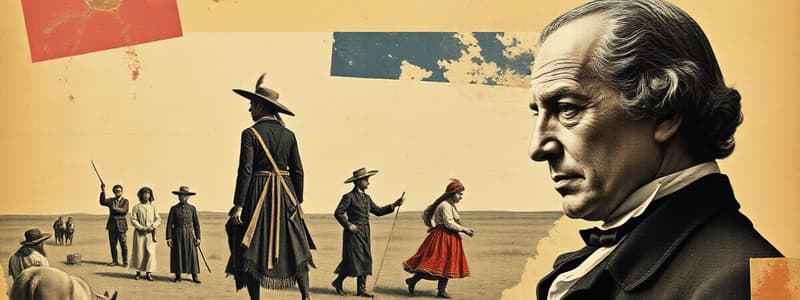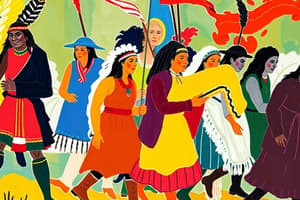Podcast
Questions and Answers
Which present-day state was designated as Indian Territory in 1834?
Which present-day state was designated as Indian Territory in 1834?
- Oklahoma (correct)
- Mississippi
- Georgia
- Florida
Which of the following actions did the Indian Removal Act allow the federal government to do?
Which of the following actions did the Indian Removal Act allow the federal government to do?
- Negotiate treaties with Native Americans (correct)
- Force assimilation into American culture
- Take land without payment
- Establish new tribal homelands in the East
Which leader led a group of Sauk and Fox people back to their homeland in Illinois in 1832?
Which leader led a group of Sauk and Fox people back to their homeland in Illinois in 1832?
- Winfield Scott
- Andrew Jackson
- Black Hawk (correct)
- Osceola
What name was given to the forced journey of the Cherokee people to the West?
What name was given to the forced journey of the Cherokee people to the West?
Which state did the Cherokee people consider themselves a separate nation within?
Which state did the Cherokee people consider themselves a separate nation within?
Which group successfully resisted efforts to be removed from their land?
Which group successfully resisted efforts to be removed from their land?
Which President supported the settlers' demand for Native American removal?
Which President supported the settlers' demand for Native American removal?
What did the Five Civilized Tribes develop to maintain safety in their region?
What did the Five Civilized Tribes develop to maintain safety in their region?
What was the main reason the area west of the Mississippi was initially considered unsuitable for farming by settlers?
What was the main reason the area west of the Mississippi was initially considered unsuitable for farming by settlers?
Which group joined forces with the Seminole to attack white settlements in Florida?
Which group joined forces with the Seminole to attack white settlements in Florida?
What military tactic did the Seminole use against white settlements in Florida?
What military tactic did the Seminole use against white settlements in Florida?
What was the name of the battle where Seminole ambushed and defeated soldiers in 1835?
What was the name of the battle where Seminole ambushed and defeated soldiers in 1835?
The Five Civilized Tribes were located in which part of the country?
The Five Civilized Tribes were located in which part of the country?
Which 1832 Supreme Court case ruled that Georgia had no right to interfere with the Cherokee?
Which 1832 Supreme Court case ruled that Georgia had no right to interfere with the Cherokee?
What did the Cherokee do when they refused to honor the treaty?
What did the Cherokee do when they refused to honor the treaty?
Who was the General that came with an army of 7,000 federal troops to move the Cherokee west?
Who was the General that came with an army of 7,000 federal troops to move the Cherokee west?
In present-day Oklahoma, The Five Civilized Tribes were relocated to lands claimed by the Osage, Comanche and who else?
In present-day Oklahoma, The Five Civilized Tribes were relocated to lands claimed by the Osage, Comanche and who else?
What did the Five Tribes improve and build once settled in their new homes?
What did the Five Tribes improve and build once settled in their new homes?
The area of present-day Oklahoma became part of the United States with the...
The area of present-day Oklahoma became part of the United States with the...
Flashcards
Who are the "Five Civilized Tribes"?
Who are the "Five Civilized Tribes"?
Cherokee, Creek, Seminole, Chickasaw, and Choctaw tribes living in the southeastern United States.
What is the Indian Removal Act?
What is the Indian Removal Act?
An act passed in 1830 that allowed the federal government to pay Native Americans to move west.
What is the Indian Territory?
What is the Indian Territory?
Created in 1834, an area in present-day Oklahoma designated for Native Americans from the Southeast.
How was the Cherokee Nation viewed?
How was the Cherokee Nation viewed?
Signup and view all the flashcards
What was Worcester v. Georgia (1832)?
What was Worcester v. Georgia (1832)?
Signup and view all the flashcards
What is the Trail of Tears?
What is the Trail of Tears?
Signup and view all the flashcards
Who was Black Hawk?
Who was Black Hawk?
Signup and view all the flashcards
Who are the Seminole?
Who are the Seminole?
Signup and view all the flashcards
What was the Dade Massacre?
What was the Dade Massacre?
Signup and view all the flashcards
Who were the Lighthorsemen?
Who were the Lighthorsemen?
Signup and view all the flashcards
Study Notes
- Large numbers of Native Americans lived in the eastern part of the country in the 1830s, after the United States had expanded westward.
- The tribes established farming societies with successful economies.
"Five Civilized Tribes"
- The "Five Civilized Tribes" lived in Georgia, Alabama, Mississippi, and Florida.
- The "Five Civilized Tribes" included the Cherokee, Creek, Seminole, Chickasaw, and Choctaw.
- Many settlers wanted the federal government to relocate Native Americans living in the Southeast due to land.
- The area west of the Mississippi was dry and thought unsuitable for farming, so few white Americans lived there.
- A proposal was made to force the Native Americans to leave their land and move west of the Mississippi River.
- President Andrew Jackson supported the settlers' demand for Native American land.
The Indian Removal Act
- Congress passed the Indian Removal Act in 1830.
- This act allowed the federal government to pay Native Americans to move west.
- President Jackson sent officials to negotiate treaties with Native Americans of the Southeast.
- Most Native Americans felt forced to accept payment for their lands.
- In 1834 Congress created the Indian Territory, an area in present-day Oklahoma, for Native Americans from the Southeast.
- Through treaties in the 1790s, the federal government recognized the Cherokee people in the state of Georgia as a separate nation with their own laws.
- The Cherokee Nation refused to give up its land.
- Georgia refused to recognize Cherokee laws.
- President Jackson supported Georgia's efforts to remove the Cherokee.
- In Worcester v. Georgia (1832), Chief Justice John Marshall ruled that Georgia had no right to interfere with the Cherokee.
- The Cherokee sued the state government and eventually took their case to the Supreme Court.
- Only the federal government had authority over matters involving the Cherokee.
The Trail of Tears
- Most of the 17,000 Cherokee refused in 1835 to honor the federal government treaty giving up their people's land.
- The Cherokee wrote a protest letter to the government and people of the United States.
- The Cherokee plea for understanding did not soften the resolve of President Jackson or the white settlers of the area.
- In 1838 General Winfield Scott and an army of 7,000 federal troops arrived to remove the Cherokee from their homes and lead them west.
- General Scott threatened to use force if the Cherokee did not leave, emphasizing their position of troops made resistance hopeless.
- The Cherokee knew resistance would only lead to destruction.
- Because the Cherokee were filled with sadness and anger, their leaders gave in so the long march to the West began.
- The forced journey west became known to the Cherokee people as the Trail Where They Cried, and is called the Trail of Tears by historians.
- Brutal weather claimed thousands of Cherokee lives along the way.
Native American Resistance
- In 1832 the Sauk chieftain, Black Hawk, led a force of Sauk and Fox people back to Illinois, their homeland.
- They wanted to recapture this area, which had been given up in a treaty.
- The Illinois state militia and federal troops responded with force, gathering nearly 4,500 soldiers.
- The Fox and Sauk were chased to the Mississippi River and slaughtered as they tried to flee westward into present-day Iowa.
- The Seminole people of Florida were the only Native Americans that successfully resisted their removal.
- Despite being pressured in the early 1830s to sign treaties giving up their land, the Seminole chief Osceola, and some of his people refused to leave Florida, deciding to go to war against the United States instead.
- In 1835 the Seminole joined forces with a group of African Americans in order to attack white settlements along the Florida coast.
- The Seminole used guerrilla tactics, making surprise attacks and then retreating back into the forests and swamps.
- In December 1835, Seminole ambushed soldiers under the command of Major Francis Dade, with only a few of the 110 soldiers surviving the attack.
- The Dade Massacre pressured the call for more troops and equipment to fight the Seminole.
- By 1842 more than 1,500 American soldiers had died in the Seminole wars.
- The government gave up and allowed some of the Seminole to remain in Florida.
- Many Seminole, however, had died in the long war, with many more captured and forced to move westward.
- Native Americans had given up more than 100 million acres of eastern land to the federal government.
- They had received in return about $68 million and 32 million acres in lands west of the Mississippi River.
- After 1842 only a few scattered groups of Native Americans lived east of the Mississippi because most had been removed to the West.
- There they lived, divided by tribes, in reservations that would eventually face intrusion from white civilization.
- The Five Civilized Tribes were relocated in the eastern half of present-day Oklahoma on lands claimed by several Plains groups, including the Osage, Comanche, and Kiowa.
- The area of present-day Oklahoma became part of the United States in 1803 with the Louisiana Purchase.
- The United States set aside this area as the home for various Native American groups.
- United States Army leaders got agreements from the Plains groups to let the Five Civilized Tribes live in peace.
- Settled in their new homes, the Five Tribes developed their governments, improved their farms, and built schools.
- The Five Tribes also developed a police force called the Lighthorsemen.
- This law enforcement unit maintained safety for the region.
Studying That Suits You
Use AI to generate personalized quizzes and flashcards to suit your learning preferences.




